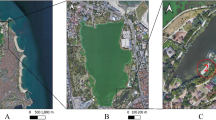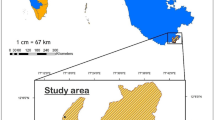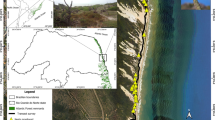Abstract
The Great Spotted Woodpecker Dendrocopos major (L.), one of the natural predators of Anoplophora glabripennis (Motsch.) (Coleoptera: Cerambycidae), is resident to Wulate Qianqi County of the Inner Mongolia and widely found in shelter plantations. In August 2005 and 2006, 174 and 153 nest-cavities of Great Spotted Woodpeckers were found respectively in Wulate Qianqi County and 22 breeding nest-cavities were investigated in 2007. The results showed that mostly willow species were selected for nesting by the Great Spotted Woodpecker, but mature poplar trees also could be chosen. Nest cavities were often found with a protuberance above the cavity entrance or with a downward sloping gradient, or both. The selection of the height of the nest-cavity height was not significant. The vertical diameter of the nest-cavity entrance (VDE) and the horizontal diameter of the nest-cavity entrance (HDE) ranged from 5.0 to 5.8 cm. The results also indicated that the compass orientation of more than 60% of nest-cavities were towards the north, northeast and east. This study suggests a convergence of some nest-cavity characteristics of the Great Spotted Woodpecker in shelter plantations and will help us to make artificial nest for conserving the woodpecker and, as well, use the bird for controlling pests.
Similar content being viewed by others
References
Adkins Giese C L, Cuthbert F J. 2003. Influence of surrounding vegetation on woodpecker nest tree selection in oak forests of the Upper Midwest, USA. For Ecol Manage, 179(3): 523–534
Caccamise D F. 1977. Breeding success and nest site characteristics of the Red-winged Blackbird. Wilson Bull, 89(3): 396–403
Chang J C, Ma J S, Lu C H. 1998. Ornithology. Harbin: North east Forestry University Press, 107 (in Chinese)
Cody L M. 1985. Habitat Selection in Birds. Orlando: Academic Press
Conner J V. 1975. Orientation of entrances to woodpecker nest-cavities. Auk, 92(2): 371–374
Conner R N, Johnson R H, Rudolph D C, Saenz D. 2003. Do red-cockaded woodpeckers select cavity trees based on chemical composition of pine resin? Wilson Bull, 115(4): 397–402
Gao W, Zhao H, Deng Q X. 1997. Research on nest-site selection of spotted woodpecker. J Northeast Norm Univ (Nat Sci Ed), 47(3): 15–21 (in Chinese with English abstract)
Grzegorz M, Maciej G, Przemyslaw C. 2001. Woodpeckers as indicators of forest bird diversity. Conserv Biol, 15(1): 208–217
Hilden O. 1965. Habitat selection in birds. Ann Zool Fenn, 2: 53–75
Inouye D W. 1976. Nonrandom orientation of entrance holes to woodpecker nests in aspen trees. The Condor, 78: 101–102
Ivanchev V P. 1997. Multiple use of breeding cavities by the great spotted woodpecker Dendrocopos major. Russ J Field Ornithol, 71: 525–530
John D L, Thomas E M. 2004. Nest-site preference and maternal effects on offspring growth. Behav Ecol, 15(5): 816–823
Johnsgard P A. 1986. The Pheasants of the World. Oxford: Oxford University Press
Li G, Re X, Zhang J Y, 2000. Primary study on controlling Anoplophora glabripennis Motsch with woodpecker. Inner Mongol For Invest Design, 4: 34–36 (in Chinese with English abstract)
Luo Y Q, Wen J B, Xu Z C. 2003. Current situation of research and control on poplar longhorned beetle, especially for Anoplophora glabripennis in China. Nachrichtenbl Deut Pflanzenschuzd, 55: 66–67
Mazgajski T D. 2002. Nesting phenology and breeding success in great spotted woodpecker Picoides major near Waraw (central Poland). Acta Ornithol, 37: 1–5
Michalek K G, Miettinen J. 2003. Dendrocopos major Great Spotted Woodpecker. BWP Update, 5(2): 101–184
Ni X J, Zheng G M, Zhang Z W, Liu N F. 2001. Modelling study on the nesting habitat of ring-necked pheasant (Phasianus colchicus). Acta Ecol Sin, 21(6): 969–977 (in Chinese with English abstract)
Pasinelli G. 2007. Nest site selection in middle and great spotted woodpeckers Dendrocopos medius & D. major: implications for forest management and conservation. Biodiver Conserv, 16(4): 1,283–1,298
Rendell W B, Robertson R J. 1994. Cavity entrance orientation and nest site used by secondary hole-nesting birds. J Field Ornithol, 65(1): 27–35
Rudolph D C, Conner R N. 1991. Cavity tree selection by red-cockaded woodpeckers in relation to tree age. Wilson Bull, 103(3): 458–467
Smith K W. 1997. Nest site selection of the Great Spotted Woodpecker Dendrocopos major in two oak woods in southern England and its implications for woodland management. Biol Conserv, 80: 283–288
Smith K W. 2005. Has the reduction in nest-site competition from Starlings Sturnus vulgaris been a factor in the recent increase of Great Spotted Woodpecker Dendrocopos major numbers in Britain? Bird Stud, 52(3): 307–313
Stauffer D F, Best L B. 1982. Nest-site selection by cavity-nesting birds of riparian in Iowa. Wilson Bull, 94(3): 329–337
Valkama J, Korpimaki E, Tolonen P. 1995. Habitat utilization, diet and reproductive success in the kestrel in a temporally and spatially heterogeneous environment. Ornis Fenn, 72(2): 49–61
Wang H T, Gao W, Wan D M, Liu D, Deng W H. 2003. Nest-site characteristics and reproductive success of five species of birds breeding in natural cavities. Acta Ecol Sin, 23(7): 1,378–1,385
Yang W K, Zhong W Q, Gao X Y. 2000. Progress of habitat selection in birds. Arid Zone Res, 17(3): 71–78 (in Chinese with English abstract)
Zhang Z X. 1992. Study on the use of Dendrocopos major for control of stem borers. For Pest Dis, 11(3): 33–34 (in Chinese)
Ziemowit K, Paweł K, Aleksander W. 2006. Nest sites of Great Spotted Woodpeckers Dendrocopos major and Middle Spotted Woodpeckers Dendrocopos medius in near-natural and managed riverine forests. Acta Ornithol, 41(1): 21–32
Ziemowit K, Paweł K. 2007. Nest holes of Great Spotted Woodpeckers Dendrocopos major and Middle Spotted Woodpeckers D. medius: Do they really differ in size? Acta Ornithol, 42(1): 45–52
Author information
Authors and Affiliations
Corresponding author
Rights and permissions
About this article
Cite this article
Wan, T., Hu, Jf., Jiao, Zb. et al. Nest-cavity characteristics of the Great Spotted Woodpecker Dendrocopos major in shelter plantations of west Inner Mongolia. For. Stud. China 10, 36–40 (2008). https://doi.org/10.1007/s11632-008-0010-1
Received:
Accepted:
Published:
Issue Date:
DOI: https://doi.org/10.1007/s11632-008-0010-1




